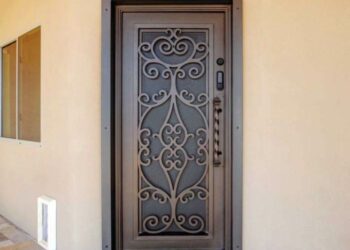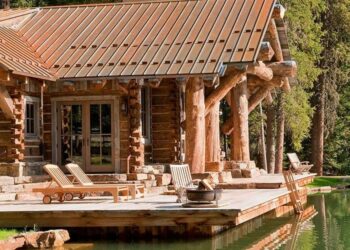Porch enclosure installation opens the door to a world of possibilities, where your outdoor space transforms into a cozy retreat. From selecting the right materials to navigating the installation process, this guide delves into every aspect you need to know.
As we dive deeper, you'll uncover valuable insights that will help you make informed decisions and create the porch enclosure of your dreams.
Overview of Porch Enclosure Installation
Porch enclosure installation involves the process of adding walls, windows, and sometimes a roof to an existing porch to create a more enclosed space. This transformation can provide various benefits to homeowners, making their porch more functional and enjoyable throughout the year.
Benefits of Installing a Porch Enclosure
- Extended Living Space: A porch enclosure can create an additional room in your home, perfect for relaxing, entertaining guests, or simply enjoying the outdoors in a protected environment.
- Enhanced Comfort: By enclosing your porch, you can block out insects, dust, and other outdoor elements, allowing you to enjoy your outdoor space in greater comfort.
- Increased Privacy: With a porch enclosure, you can enjoy more privacy from neighbors and passersby, making your porch a more intimate space for you and your family.
- Protection from the Elements: A porch enclosure can shield you from rain, wind, and harsh sunlight, enabling you to use your porch in all types of weather.
Different Types of Materials Used for Porch Enclosures
- Screen: Screen porch enclosures are a popular choice for those looking to keep insects out while still enjoying fresh air and natural light.
- Glass: Glass porch enclosures provide a clear view of the outdoors and can offer better insulation, making them suitable for year-round use.
- Polycarbonate: Porch enclosures made of polycarbonate are lightweight, durable, and resistant to impact, making them a practical option for protection from the elements.
- Aluminum: Aluminum porch enclosures are low-maintenance, rust-resistant, and customizable to fit different design preferences.
Planning for Porch Enclosure Installation
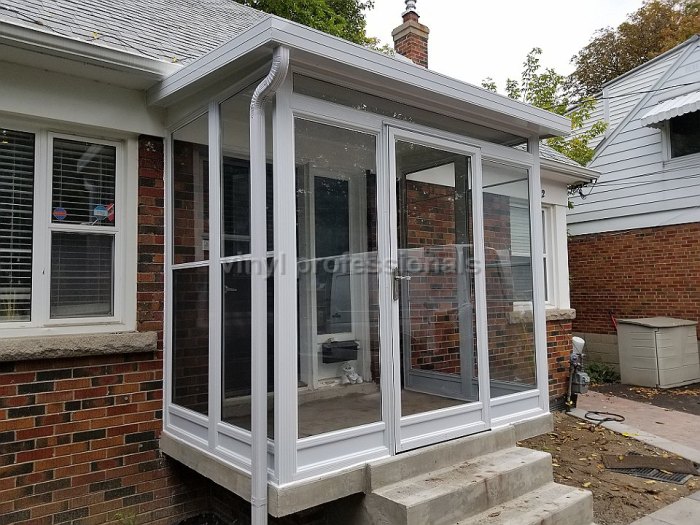
When planning for a porch enclosure installation, there are several important steps to consider to ensure a successful project. From choosing the right design to obtaining necessary permits, proper planning is crucial for a smooth installation process.
Choosing the Right Design for a Porch Enclosure
When selecting a design for your porch enclosure, consider factors such as the style of your home, the purpose of the enclosure, and your budget. Some popular porch enclosure designs include screened-in porches, three-season rooms, and sunrooms. It's essential to choose a design that complements the existing architecture of your home while meeting your functional needs.
- Consider the materials: Determine whether you want a porch enclosure made of glass, screen, or a combination of both. Each material has its benefits and drawbacks, so choose based on your preferences and climate considerations.
- Think about ventilation and lighting: Ensure that your porch enclosure design allows for adequate airflow and natural light to create a comfortable and inviting space.
- Consult with a professional: If you're unsure about which design would work best for your home, consider consulting with a contractor or designer who specializes in porch enclosures.
Permits and Regulations for Porch Enclosure Installation
Before starting the installation process, it's crucial to check with your local building department to determine if any permits or regulations are required for a porch enclosure. Failure to obtain the necessary permits can result in fines or the need to remove the enclosure altogether.
Ensure that your porch enclosure installation complies with local building codes and zoning regulations to avoid any legal issues down the line.
- Permit requirements: Some areas may require a building permit for porch enclosure installation, while others may have specific guidelines for setbacks, height restrictions, and materials used.
- HOA guidelines: If you live in a neighborhood with a homeowners association (HOA), you may need approval from the HOA board before installing a porch enclosure to ensure it meets community standards.
- Environmental considerations: Depending on your location, there may be additional regulations related to environmental impact, energy efficiency, or conservation efforts that need to be taken into account during the planning process.
Preparing for Porch Enclosure Installation
Before starting the porch enclosure installation, it is essential to gather the necessary tools and materials and prepare the existing porch structure for the enclosure.
Tools and Materials Needed
- Tape measure
- Level
- Drill
- Screwdriver
- Saw
- Screws/nails
- Screen or glass panels
- Weatherstripping
- Caulk
Preparing the Existing Porch Structure
Before installing the enclosure, carefully inspect the existing porch structure to ensure it is sturdy and in good condition. Remove any debris or obstructions from the area and clean the surface for a smooth installation process. Consider painting or staining the porch if needed for a fresh look.
Necessary Adjustments or Modifications
If the existing porch structure requires any adjustments or modifications to accommodate the enclosure, such as reinforcing weak spots or adding additional support, it is crucial to address these issues before installation. Ensure that the porch is structurally sound and able to support the weight of the enclosure to prevent any safety hazards in the future.
Installing the Porch Enclosure
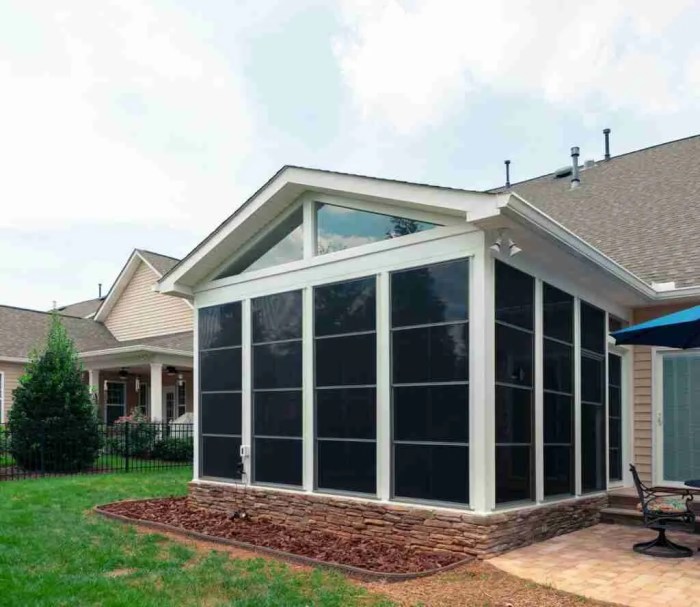
Installing a porch enclosure requires careful planning and precise execution to ensure a secure and durable final product. From setting up the structure to sealing all gaps, each step plays a crucial role in the installation process.
Structural Integrity
- Start by carefully following the manufacturer's instructions for assembling the enclosure frame. Ensure all pieces fit together securely to provide a strong foundation.
- Use the appropriate tools and hardware to secure the frame in place, making sure it is level and plumb before proceeding to the next steps.
- Check for any gaps or loose connections in the frame and reinforce them as needed to prevent any structural weaknesses.
Weatherproofing
- Apply a high-quality sealant or caulk around all joints and connections to prevent water infiltration. This will help protect the enclosure from moisture damage and extend its lifespan.
- Consider installing weather-stripping around doors and windows to create a tight seal and improve insulation. This will enhance the energy efficiency of the porch enclosure.
- Inspect the entire structure for any potential leaks or weak spots, addressing them promptly to maintain the integrity of the enclosure.
Finishing Touches
- Add any desired finishing touches, such as trim work or decorative elements, to enhance the appearance of the porch enclosure.
- Ensure all doors and windows are properly installed and functioning correctly, with secure locks and smooth operation.
- Test the overall stability of the porch enclosure by gently rocking or pushing on different areas to identify any potential issues that need to be addressed.
Finishing Touches and Maintenance
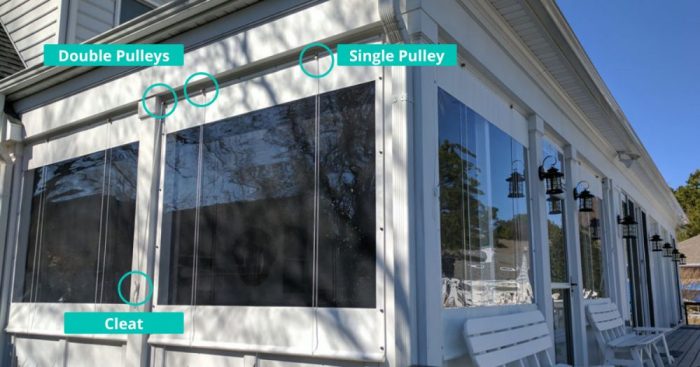
When it comes to finishing touches for a porch enclosure, small details can make a big difference in enhancing the overall appearance and functionality of the structure. Additionally, proper maintenance is essential to ensure the longevity and durability of the porch enclosure post-installation.
Enhancing Appearance with Finishing Touches
- Consider adding decorative elements such as trim work, molding, or architectural details to enhance the aesthetic appeal of the porch enclosure.
- Install lighting fixtures or lanterns to create a warm and inviting ambiance, especially for evening gatherings or relaxation.
- Choose a complementary paint color or finish that blends seamlessly with the existing exterior of your home, creating a cohesive look.
- Add potted plants, hanging baskets, or window boxes to bring a touch of nature and greenery to the porch enclosure, creating a welcoming environment.
Maintenance and Care Post-Installation
- Regularly clean the porch enclosure using a mild detergent and water to remove dirt, dust, and debris that can accumulate over time.
- Inspect the structure for any signs of wear and tear, such as loose screws, damaged screens, or cracks, and promptly address any issues to prevent further damage.
- Ensure that the door hinges, locks, and handles are properly lubricated to maintain smooth operation and prevent rust or corrosion.
- During seasonal changes, check for any gaps or leaks in the porch enclosure to ensure that it remains weather-tight and secure.
Repairs and Upkeep Tasks Over Time
- Replace worn-out screens or damaged panels to maintain the functionality and appearance of the porch enclosure.
- Re-caulk any gaps or seams to prevent water infiltration and drafts, especially around windows, doors, and joints.
- Inspect the roof or ceiling of the porch enclosure for any signs of water damage, mold, or mildew, and address any issues promptly to prevent further deterioration.
- Regularly trim vegetation or plants around the porch enclosure to prevent overgrowth that can cause damage or obstruct airflow.
Conclusive Thoughts
As we conclude this exploration of porch enclosure installation, remember that this enhancement not only adds value to your home but also enriches your lifestyle. Embrace the beauty and functionality it brings, and enjoy your newly enclosed porch for years to come.
Q&A
What are the benefits of porch enclosure installation?
Porch enclosure installation offers added living space, protection from the elements, increased home value, and enhanced aesthetics.
What tools and materials are needed for porch enclosure installation?
Common tools include a drill, screwdriver, level, and measuring tape. Materials may vary but often include glass, vinyl, or aluminum.
How to maintain a porch enclosure post-installation?
Regular cleaning, checking for any damage, and addressing issues promptly are key to maintaining a porch enclosure.

